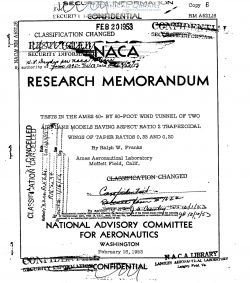naca-rm-a52l16
- Version
- 37 Downloads
- 1.42 MB File Size
- 1 File Count
- August 13, 2017 Create Date
- August 13, 2017 Last Updated
National Advisory Committee for Aeronautics, Research Memorandum - Tests in the Ames 40 x 80 Foot Wind Tunnel of two Airplane Models Having Aspect Ratio 2 Trapezoidal Wings of Taper Ratios 0.33 and 0.20

Tests have been.made of two airplane models having trapezoidal
wings of aspect ratio 2.and taper ratios of 0.33 and 0.20. For each
model, a fueelage with a fineness ratio of 12.5, a thin, triangular,
vertical tail with a constant—chord rudder, and a thin, unswept, all-
movable horizontal.tail was used. The wings had an NACA 0005 modified
section and were equipped with slotted, trailing-edge flaps. Tbsts of
the wing-fuselage vertical—tail configuration and of the complete
airplane model were made for both models. Tests were made with the
horizontal tail at each of three vertical locations. The flaps were
tested as high-lift and lateral-control devices. When mounted on the
model having a wing of taper ratio 0.33, the horizontal tail was tested
as a lateral control by giving the two surfaces antisymmetric deflec-
tions.- The ReynOlds numbers, based on the wing mean aerodynamic chord,
were approximately 11. h and 13.0 million for the taper ratios 0.33
and 0.20 wings, respectively. The Mach number was approximately 0.13.
No analysis is made of the data presented.
The low-speed aerodynamic characteristics of triangularswing
airplane models having wings of aspect ratios 2, 3, and h have been
under investigation in the Ames ho- by 80-foot wind tunnel, and results
have been_reported in references 1, 2, and 3.‘ Interest has been
expressed in the aerodynamic characteristics of these wings when the
plan form was modified by the removal of the pointed tips. As a result
of this interest, tests were carried.out on the aspect ratios 3 and h
triangular—wing models with the wing plan forms modified to form trape-
zoidal wings of aspect ratio 2 and taper ratios_of 0.20 and 0.33,
respectively.
Tests were made to ascertain the effectiveness of a high—lift
device, two types of lateral controls, and a directional control, using
control—surface deflections typical of those used in landing. The
horizontal tail was tested in three vertical locations in order to
determine the,effeot of horizontal-tail vertical location on the longi—
tudinal stability. The wings of both models had slotted, trailing—edge
flaps which were tested both.as high:liftudevigesnan§_lateral cpntrolay
An all-movable horizontal tail was tested as a longitudinal control on
both models, and as a'lateral control on one of the models. A rudder
of constant chord was tested as a directional control on one model.
| File | Action |
|---|---|
| naca-rm-a52l16 Tests in the Ames 40 x 80 Foot Wind Tunnel of two Airplane Models Having Aspect Ratio 2 Trapezoidal Wings of Taper Ratios 0.33 and 0.20.pdf | Download |
Comment On This Post